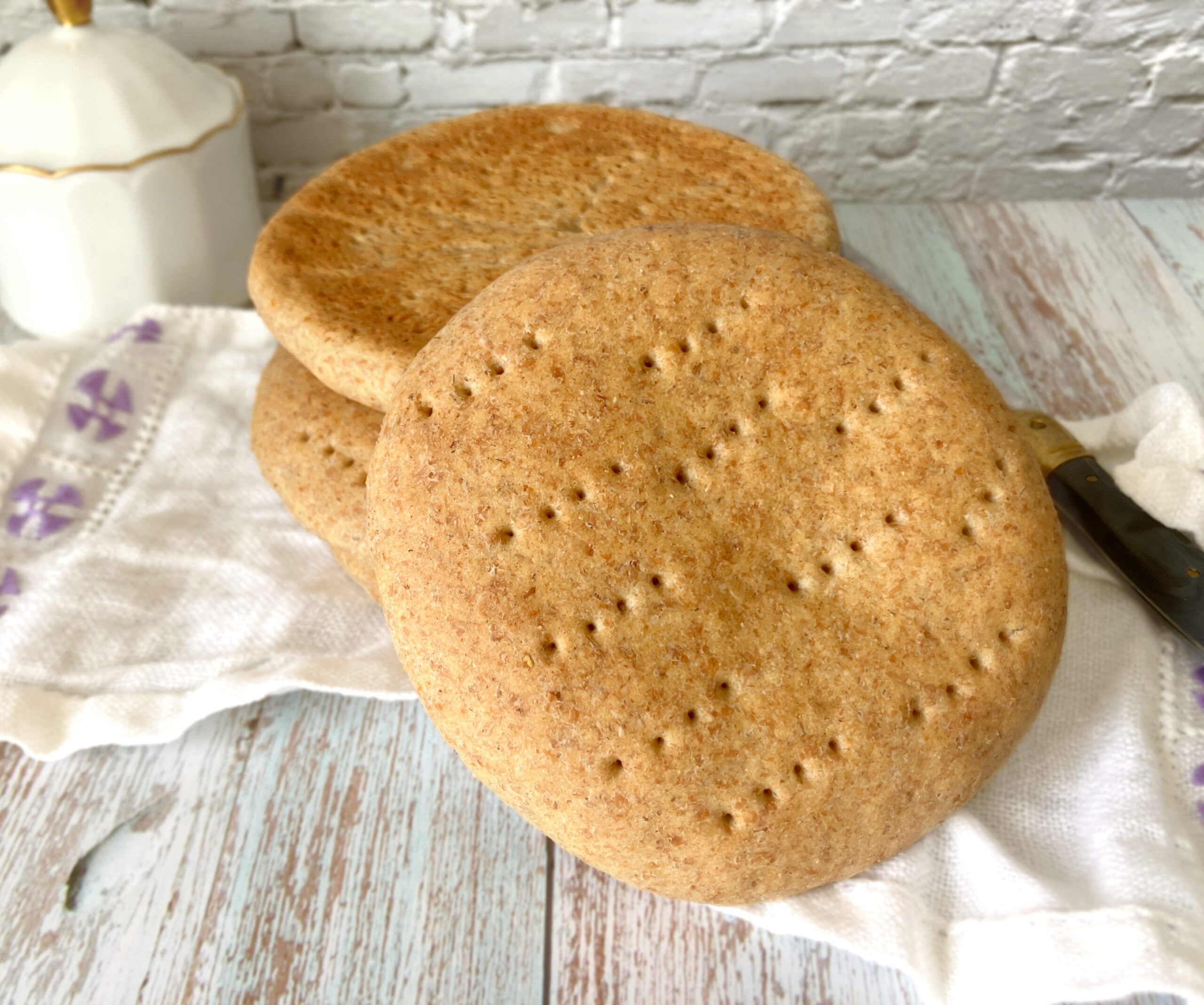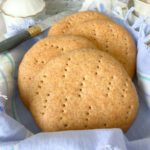Swedish Tekakor with Wholegrain Spelt
If you’re looking to bring a taste of Sweden into your kitchen, this recipe for Swedish tekakor is a perfect place to start. These distinctive round flatbreads have been a beloved staple in Swedish homes for generations.
Made with wholesome wholegrain spelt flour and a touch of gräddfil, they’re easy to prepare and wonderfully versatile. Whether you enjoy them simply buttered or topped with your favourite open sandwich fillings, these bread buns offer a delicious, traditional flavour that’s perfect any time of day.
If you are new to spelt flour and would like to know more, please check out my tutorial: The Beginner’s Guide to Spelt Flour.
Swedish tekakor with wholegrain spelt
This recipe is a slightly heartier take on a Swedish classic, made with wholegrain spelt flour, gräddfil, and a little butter for softness. While tekakor are sometimes lightly sweetened, this version contains no added sugar, just simple, pantry ingredients.
With two fairly short rises, the buns are quick to make, and the dough is easy to work with. You can either roll the dough and cut out the rolls, or, as I did, roll them individually. The end result is delicious flat rounds that are mild in flavour and versatile.
The ingredients make four perfectly sized buns, but it is an easy to adapt recipe, and you could make more if you preferred.
What are Swedish tekakor?
Tekakor are soft, round Swedish flatbreads traditionally served for breakfast or fika. Directly translated, the name means tea cakes. However, they’re certainly not to be confused with English teacakes, which are light, fruited buns. Swedish tekakor are savoury, fairly plain, and usually eaten as open sandwiches.
The history of tekakor goes back generations, but they became especially popular in Sweden during the mid-1900s, as softer, processed breads became more common in everyday households. They were easy to make at home, required no fancy shaping, and offered a softer option compared to rye crispbreads or dark loaves.
One of the most recognisable features of tekakor is the series of small fork pricks across the top. This traditional step isn’t just for decoration, it helps stop large bubbles from forming as the bread bakes, keeping the surface smooth and flat. It’s also part of what sets tekakor apart visually from other soft rolls or buns.
Sizes vary, many shop-bought versions are as wide as a side plate, but this version is slightly smaller. They are also quite famous for being pillowy soft, but as I’ve made mine with wholegrain spelt flour, they’re a little denser but more wholesome. Still delicious, just a bit heartier.
How Swedes enjoy tekakor
In Sweden, tekakor are incredibly versatile and enjoyed throughout the day. Their soft texture and mild flavour make them perfect for quick breakfasts, light lunches, or fika treats.
They are flat and thin for a reason: you don’t slice and fill them. Swedes love an open sandwich. The toppings are usually piled onto the slightly domed, softer side. The flat side is usually a little firmer and acts as a sturdy base, so your open sandwich stays intact without the bread falling apart. That said, with naturally firmer tekakor, like these, you could easily have the top facing up. This would give you a flatter working surface to balance as many delicious things as possible on top.
Most commonly, Swedes spread tekakor with butter and top them with cheese or a dollop of jam for a simple, satisfying bite. But tekakor are far from just a plain snack. They often serve as the perfect base for one of Sweden’s favourite open-faced sandwiches: räkmackor. They are very generous open sandwiches piled high with shrimp, lashings of mayonnaise, boiled eggs, a bed of lettuce and cucumber. This classic is a lunchtime favourite and a common sight at cafés and bistros across Sweden. Feast your eyes on the delicious specimen below:
The beauty of tekakor is their simplicity and adaptability. They’re as comfortable holding sweet toppings like honey or jam as they are carrying savoury layers of cheese, cold cuts, or seafood. Whether you prefer a humble buttered slice or a piled-high shrimp sandwich, tekakor fit seamlessly into the rhythm of everyday Swedish life.
Why gräddfil is used in Swedish bread recipes
One ingredient that often appears in traditional Swedish bread recipes, including tekakor, is gräddfil. This is a type of cultured sour cream, thicker and creamier than regular sour cream, with a mild tangy flavour.
It adds moisture, richness, and a subtle acidity that helps balance the bread’s flavour and contributes to a soft, tender crumb.
In tekakor, gräddfil works alongside yeast and flour to create a dough that’s easy to handle and results in that classic light yet wholegrain texture. Its acidity gently breaks down gluten, making the bread softer without weighing it down, which is especially important when using wholegrain flours like spelt. Gräddfil is also great in cakes, too, offering the same additional moisture, like in my freeze-dried raspberry no sugar cake.
Alternatives for gräddfil (including vegan options)
If you can’t find gräddfil locally or prefer not to use dairy, there are some great substitutes that work well:
- Sour cream or crème fraîche can be used as a direct replacement in most recipes, though they may be slightly thinner or less tangy.
- Greek yogurt offers similar creaminess and tang, but you may need to adjust the quantity slightly because of its thicker consistency.
For vegan options, there are several plant-based alternatives:
- Vegan sour cream made from coconut, soy, or cashews can provide the creaminess and slight tang you want.
- A mixture of plant-based yogurt, such as almond or soy yogurt, with a splash of lemon juice or apple cider vinegar mimics the acidity of gräddfil.
- You could also experiment with silken tofu blended with a little lemon juice for a smooth, creamy addition.
Keep in mind that some substitutes might slightly change the flavour or texture, but they still give your tekakor that lovely softness and moist crumb. If you’re experimenting with vegan or dairy-free versions, start by swapping the gräddfil in equal amounts and adjust as you go.
Using dried yeast vs fresh yeast in bread buns
In traditional Swedish baking, fresh yeast, also known as cake yeast or compressed yeast, is a staple ingredient. Many home bakers in Sweden prefer fresh yeast because of its mild flavour and reliable rise. It’s commonly used in classic bread recipes like cinnamon buns and soft cardamom bread.
If you have fresh yeast, the typical conversion is:
25 grams of fresh yeast = about 7 grams or 2¼ teaspoons of dried yeast.
Since this recipe calls for 4½ grams (1¼ teaspoons) of dried yeast, you’d use roughly 12-15 grams of fresh yeast instead, adjusting slightly depending on how quickly you want the dough to rise.
Crumble the fresh yeast into the lukewarm liquid, like milk or water, in your recipe. Stir gently until it dissolves completely. Continue with the recipe as usual.
Fresh yeast requires refrigeration and has a shorter shelf life than dried yeast, so it’s best used within a week or two. Many Swedish bakers swear by fresh yeast for its traditional texture and flavour, but dried yeast is a perfectly good and convenient substitute, especially if you don’t bake often or don’t have access to fresh yeast.
Yeast can be a little confusing even for the handiest baker. King Arthur has a really useful article All About Yeast, full of information about the different kinds and when to use them.
Tekakor
Ingredients
- 20g (1½ tbsp) butter
- 140g (½ cup + 1 tbsp) gräddfil (see note 1)
- 4½g (1¼ tsp) dried yeast (see note 2)
- 1 tsp sea salt (adjust to taste)
- 160-180g (1⅓–1½ cups) wholegrain spelt flour (see note 3)
Instructions
- Heat the butter, just until mostly melted with a few soft lumps remaining. Stir to finish melting from the residual heat.
- Mix the melted butter with the gräddfil (or your alternative choice).
- In a large bowl or stand mixer, add 160 g (1⅓ cups) of the flour, the dried yeast, and the salt. Stir to combine.
- Pour the butter and gräddfil mixture into the dry ingredients.
- Cover the bowl with a clean towel or plastic wrap and leave it to rise in a warm spot for about 45 minutes, or until doubled in size.
- Preheat the oven to 175℃ (350F).
- Turn the dough out onto a lightly floured surface.
- Divide it into four equal pieces - they should weigh about 75 g (2.6 oz) each.
- Roll each one into a circle roughly 10 cm (4 inches) in diameter. Don’t worry if they’re not perfectly round; a rustic look is completely fine.
- Place the rounds on a lined baking tray, leaving space between each one. Prick all over with a fork to prevent bubbles and give that traditional look.
- Cover loosely and let the buns rest for another 30 minutes.
- Bake in the preheated oven for around 15–17 minutes. They’re ready when the bottoms are lightly browned and sound hollow when tapped.
- Allow to cool on a wire rack, then top with your favourite toppings. Enjoy!
Notes
- If you don't have access to gräddfil, use sour cream, Greek yoghurt or even buttermilk in its place. Please find more information about substitutions.
- In Sweden we have something called dried yeast, which is used either in warm liquid or added directly to flour. In the US, there are two types of dried yeast, and I believe instant yeast is the most similar for this type of bread.
- You can use all-purpose wholegrain flour instead of spelt flour. Or, use white flour if you prefer. Use the same measurements as specified.









